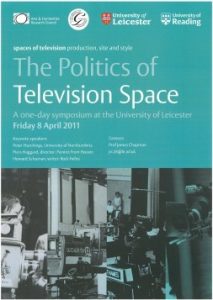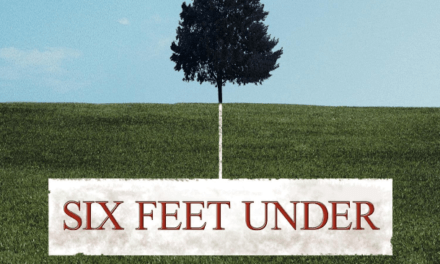I enjoyed Helen Wheatley’s CST blog of 25 May and found her ‘worrying at the question of what and who television history is for’ very pertinent to my own work for the research project ‘Spaces of Television: Production, Site and Style’. Therefore, in this, our project’s first guest blog for CST, I’d like to take the opportunity to ‘worry about’ my own historical methodology and offer some thoughts about the role of memory in TV history, a subject Wheatley touches on quite a lot. Like Wheatley, I found the BBC4 documentary Tales of Television Centre thought-provoking in terms of how TV history is done and presented, and of particular interest as a documentary dealing with a space of production and broadcasting, and I also want to comment on the reflections it provoked.
We seem to be currently experiencing a boom in British television history, measurable in part by the unprecedented number of AHRC-funded projects dedicated to the subject that are running at the moment – I know of at least five (and offer my apologies to any I have left out). Our own ‘Spaces of Television’ project based at the Universities of Reading, Glamorgan and Leicester and running until March 2014, is exploring how production spaces and technology conditioned the style of television drama between 1955 and 1994. We are keeping excellent company in the TV academic community with the Warwick/De Montfort ‘History of Television for Women in Britain, 1947-89’, Westminster’s ‘Screenplays’ project concerned with televised theatre plays from 1930 to the present, the University of Portsmouth’s research on ‘Channel Four and British Film Culture’, and work at the University of Nottingham on the ITV Southern Television franchise from 1958 to 1982. As well as reminding us of the myriad ways in which TV history is done and used, this blossoming of television history arguably makes it even more important that we remain reflexive about what we are doing and how we are doing it.
The ‘Spaces of Television’ project is concerned with issues of space in television fiction at macro and micro levels, aiming to provide broader institutionally-informed histories and case studies of production spaces – studios and locations – as well as paying close attention to the depiction of space within the television frame. In our work on the material spaces and technology of production we rely quite heavily on the memories of those who made television, who generously give up their time to share their insights into ‘how it was done’ with us. As anyone who has interviewed practitioners of television past will know, this method of research can be hugely enjoyable as both a chance to meet some delightful and interesting people, and crucially, to absorb the subject’s personal connection to the programmes, production practices and the atmosphere of the era, conveyed through the texture of their stories and anecdotes. It is just such a sense of the ‘emotional history of a production space’ that Wheatley enjoyed about the BBC4 documentary Tales of Television Centre (tx: 17/5/12) a historical account constructed entirely through the personal reminiscences of those who worked there.

Wheatley also astutely recognised that this approach generated distance between ‘them’ – those who directly experienced what the BBC was like as a workplace, and ‘us’, the audience, looking on from outside. Incidentally, as I worked at Television Centre for several years myself (in the BBC Locations Department) my own position to the programme was probably slightly more confused and complicated than most. These magical, iconic spaces depicted on screen had been largely demystified through my own daily encounter with this setting. My journey to the office took me through the ‘horse-shoe’ central courtyard, past several studios, and through one of the props stores into the then newly renovated Design Block. I regularly lunched in the BBC Club and Restaurant Block. My job did not put me in contact with the ‘stars’ of shows, and my own prior encounters with the many ‘normal’ people employed in the building who vastly outweighed the celebs, created an odd disjunction between my memories and the account of the building presented on screen. Nevertheless, at TVC I was not immune to the media buzz around me, and the knowledge of how many famous people were on site  at any moment certainly affected me. I have my own stories about celeb-spotting: I walked past Jonathan Ross in the car park wearing a yellow jumpsuit (perhaps due to interview a Kill Bill star or racing car driver, I was never sure). I warmly greeted news reporter Mark Easton in the canteen, as his face looked so familiar and normal I thought we must have been previously acquainted on a training course. This aside is
at any moment certainly affected me. I have my own stories about celeb-spotting: I walked past Jonathan Ross in the car park wearing a yellow jumpsuit (perhaps due to interview a Kill Bill star or racing car driver, I was never sure). I warmly greeted news reporter Mark Easton in the canteen, as his face looked so familiar and normal I thought we must have been previously acquainted on a training course. This aside is really just to state the obvious point that the ‘magic’ of Television Centre portrayed on screen was something mostlyexperienced by the very few, and only vaguely felt by the rest of us even within the BBC, especially after the height of the studio ‘Golden Age’, the main focus of the programme, had passed.
really just to state the obvious point that the ‘magic’ of Television Centre portrayed on screen was something mostlyexperienced by the very few, and only vaguely felt by the rest of us even within the BBC, especially after the height of the studio ‘Golden Age’, the main focus of the programme, had passed.
The undoubtedly engaging ‘emotional history’ of Tales of Television Centre and its basis in anecdote reminded me of both the pleasures and the foibles of interviewing TV makers and performers. Like the programme contributors, some of our interviewees’ stories are simply entertaining while others hold greater historical resonance, and in every subject a fondness and nostalgia for ‘what television was’ comes across, strikingly similar to the tone established in the programme as BBC employees remember Television Centre as an eccentric and dearly loved institution. And yet, as a TV scholar I also found the limitations of the anecdotal, emotional approach very frustrating. Towards the end of the programme, Sir David Attenborough makes a comment rather inconsistent with the general tenor of the programme, stating he would like the Television Centre to ‘live on through the programmes that it produced, more than the bricks and mortar’. This remark unwittingly brought to the fore how noticeably distant programmes themselves were from this documentary’s aims, which lay instead with conveying the phenomenology of this broadcasting hub. As researchers we can usually steer our interviewees into talking about the more sober nitty-gritty of production practice as opposed to more sensationalist or glamorous fare on offer, but it is notable how frequently practitioners assume that we want to hear their ‘best stories’ about working life in TV’s Golden Age, and how surprised they are by our keen interest in what they perceive as the more mundane aspects of their practice. Their perception of these details as uninteresting is perfectly consistent with the content of popular broadcasting histories such as Tales of Television Centre, as well as sometimes demonstrating their own resistance to an academicising of their former jobs, in the manner of ‘well it was just what we did’. Without incorporating more about the actual programmes that were made in TVC, the documentary couldn’t really demonstrate the enormous creative freedom given to programme makers that resonates through each and every one of the production interviews that I have conducted. The difference between ‘then’ and ‘now’ was, rather, carried more through a sense of the huge bureaucratic and organizational machine facilitating programme making which came across very clearly.

Pan’s People dancers reminisce about Television Centre
While I can recognize the tangible benefits of carving a wider role for television nostalgia and memory in the practice of television history, I remain concerned by its limitations. Of course, there are many well-rehearsed arguments regarding the qualification of personal accounts and subjective viewpoints as historical sources. We can try to be sensitive to the unreliability of memory, and even use false recollections as potentially interesting phenomena that might tell us something about the subject. But nevertheless the comments of both producers and viewers of television incorporated into published historical accounts can quickly take on the status of fact or become automatically representative of wider opinions or socio-cultural trends, even if this is not the author’s intention. As someone aspiring to understand the ways in which programmes were made and received, I find the accounts of those present at the time, are invaluable, but often contain surprising discrepancies with information from archival sources and/or with the TV text.
A more unusual, less-voiced concern is the way that dominant television viewing memories can dictate the shape of television history at the expense of the far greater number of forgotten programmes. The absence of shared memory profoundly affects the study of television drama. We are reliant on enough viewers remembering a programme for it to be made available on DVD, and we are often discouraged by publishers, mindful of audience appeal and marketing, from writing about less-remembered programmes for book publications. (A similar agenda of TV as a shared, popular institution and the BBC as national treasure clearly influenced the approach and tone of Tales of Television Centre.) And yet given the enormous volume and extreme heterogeneity of the television single play, how very few are remembered, and/or included in histories of the Golden Age period? This is one indication of how, when used as a criterion of selection, memory can pose a real barrier to exploring the content of television history. Conversely, there are many popular dramas that abide in the public’s memory but are overlooked or forgotten by academia. Close scrutiny of their spatial organization can reclaim their importance, not necessarily as exceptional programmes but as representative of production methods of their time, opening up the study of television space and aesthetics through the popular as well as the exceptional or cutting edge.
One of the aims of ‘Spaces of Television’ is to move away from vague and general characterizations of production in this period towards more detailed and specific case studies of programmes and genres that highlight aspects of studio and location practice. Close textual analysis of television texts is hence an important part of our work. The repeated viewing of whole and part, often in tandem with an informed knowledge of how the programme was made, is a methodology that insistently refuses reliance on memory and general impressions.


Close reading can be interestingly combined with interview material to form a rich multi-faceted methodology. Nevertheless, I do sense a need to carve out a greater role for programme selection processes that are not shaped by shared memory, but trust our discipline to create new memories of what television has offered to us, through writing illuminating histories that expand the corpus based on judgments of what we believe are interesting and/or enlightening programmes, figures and events in TV history. Our project’s case studies examine the treatment of space in relation to different genres (including police drama, children’s telefantasy, sci-fi and soap opera), technology (Steadicam and electronic studio effects) and production roles including writers (Howard Schuman and P J Hammond), directors (Douglas Camfield, Darrol Blake), designers (Eileen Diss and Stuart Walker) producers (Phil Redmond) and other staff. The two one-day symposia that we have held so far on the Politics of Space and Performance and Space (posters above) have attracted a huge variety of material relating to the uses and impact of studio and location spaces. For example, our Performance and Space symposium included papers on such wide ranging issues as the influence of British Actors’ Equity on BBC studio drama, to landscape in regional TV musicals, to the representation of rape in the studio police drama. Further information about our project work will soon be available on our forthcoming blogsite which will be launched very soon. Details to follow….
So, while the unearthing of forgotten programmes and figures could make it harder to find ways to engage the public beyond academia, it should not deter us from celebrating the little-known. For example the Screenplay project’s current bold and ambitious BFI Southbank season of televised Greek tragedies has proven that we can bring ‘obscure’ material to a wider audience through intelligent curating and promotion. I look forward to more forays into and beyond popular memory in this most exciting period for British TV history.
Leah Panos on behalf of the ‘Spaces of Television: Production, Site and Style’ team: Jonathan Bignell, Stephen Lacey, James Chapman, Billy Smart, Victoria Byard, Ben Lamb.
Dr Leah Panos is a Post-Doctoral Researcher on the Spaces of Television project based at the University of Reading. Recent case studies for the project include work on the use of the Steadicam in Brookside, the television plays of Howard Schuman, aesthetics in the TV studio musical Rock Follies, and the role of the designer in 1970s dramas using Colour Separation Overlay.





